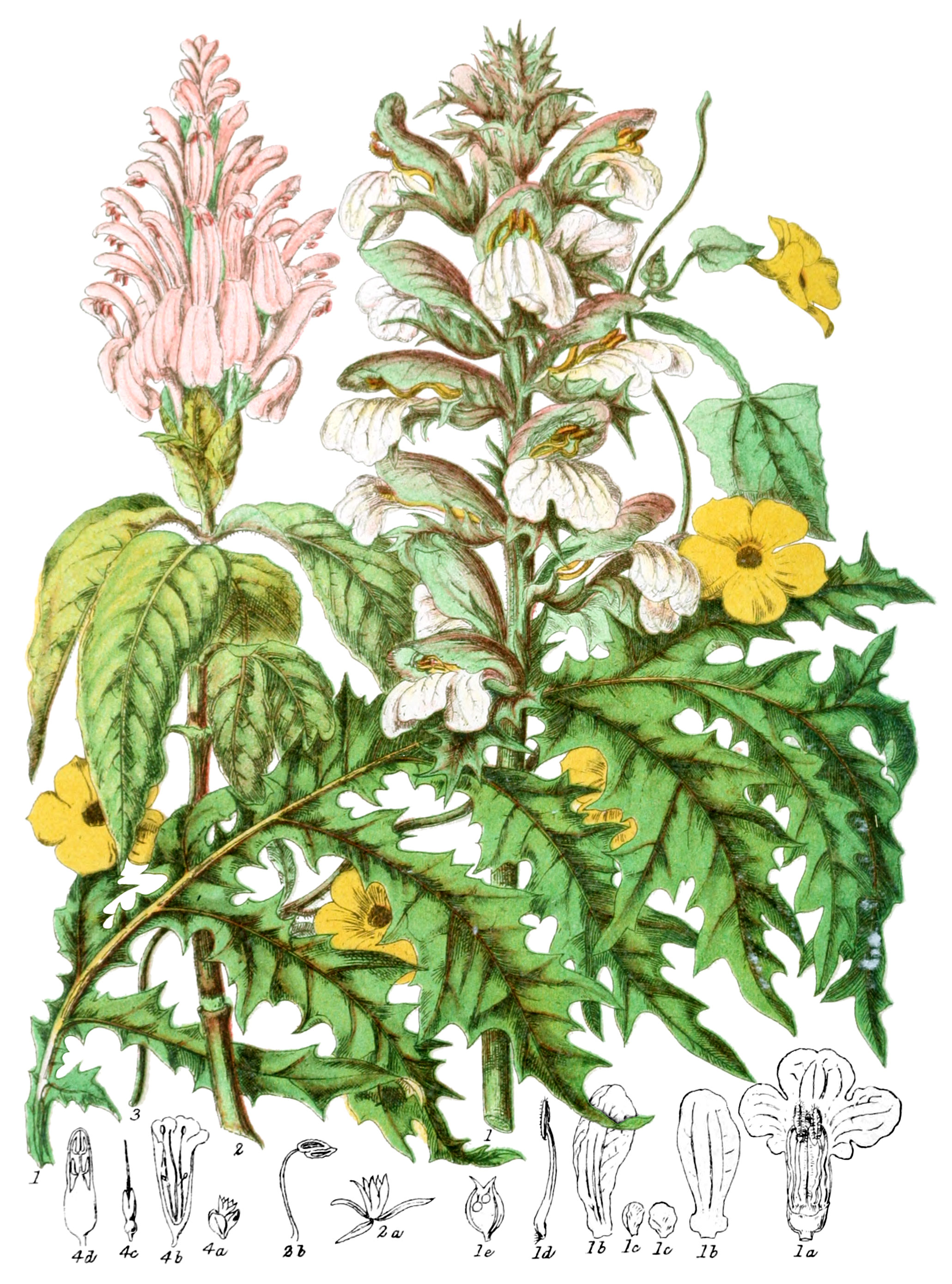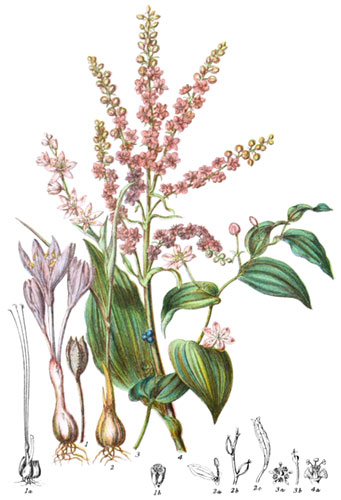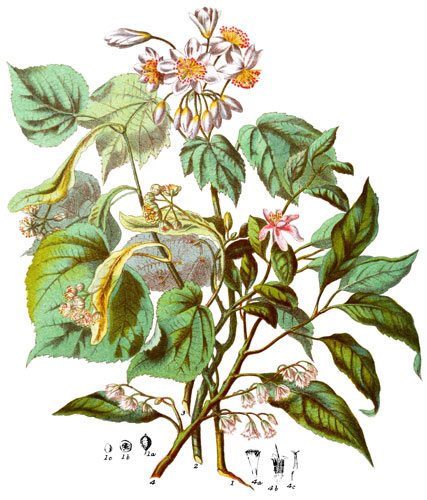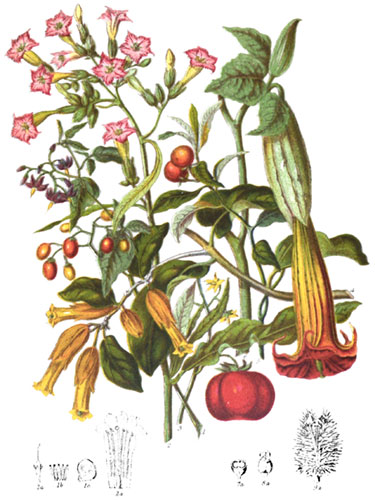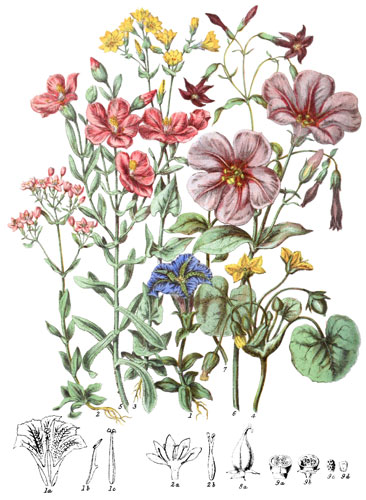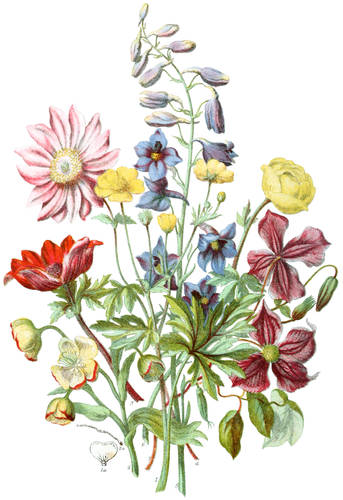Key characteristics
Shrubs and herbaceous plants, sometimes having simple hairs, very rarely in a stellate form. The leaves are opposite, rarely in fours, or unequal pairs, without stipules, simple entire at the edges, or serrated, sometimes sinuated, or lobed, and spiny. The flowers are terminal, or from the base of the leaf-stalks, in spikes, or branching panicles, sometimes solitary; opposite or alternate on the branches. At their base are three bracts; the central one usually large and leafy, and spiny if the leaves are so, enclosing the calyx, or forming a substitute for it. The calyx is four or five-lobed, equal, or unequal, the two side sepals very small in Acanthus, generally much imbricated and divided, sometimes entire, persistent, occasionally wanting as in Thunbergia. The corolla is of one petal, attached below the ovary, two-lipped, the lower lip overlapping the upper in the bud; occasionally one-lipped, as in Acanthus, sometimes nearly equal, deciduous. The stamens are usually two, both having anthers, sometimes four, the two longer only being fertile; the anthers are two or one-celled, opening lengthwise. The ovary is seated on a disk, two-celled, composed of two carpels, with one style, and a two-lobed stigma. The capsule is two-celled, the cells two or many-seeded, bursting elastically, with two valves which bear seeds on their edges. The seed are roundish, suspended by hard, cup-shaped, or hooked projections from the plats of the valves; they contain no albumen.
This Tribe has affinity with Bignoniaceæ, and Scrophulariaceæ, but is distinguished from the former by wingless seeds, and from both by the large leafy bracts, and the hooked processes attaching the seeds.
Mucilaginous and slightly bitter properties exist in these plants.
Select plants in this order
Not all plants listed are illustrated and not all plants illustrated are listed.
- Acanthus was named from the Greek for a spine, the leaves being usually spiny at all the points. Pliny describes an Acanthus on the lawn of his garden, and such a position is most favourable for it, he leaves spreading around in a very noble manner, when free space is allowed for growth; if in a border crowded amongst other plants its peculiar character is concealed. The foliage of Acanthus has the honour of having afforded one of the most elegant and permanent types of ornament to architecture. In the transparent atmosphere of Greece, the simple yet striking effects of light and shade on vegetable forms, rendered them the best and most natural objects to be adopted as studies by the skilful artist.
- A. mollis has extremely large, gracefully waved leaves, which may be clearly traced in classical art.
- A. spinosus (1) is a beautiful species, perfectly hardy in our climate; the spike of flowers rises to three feet in height, and being of a firm texture, remains long an embellishment to the garden. The petal is one-lipped, the large upper sepal of the unequal calyx forming a kind of hood to the stamens and pistil. The capsule shows the chief distinguishing mark of this Order, the hooks which support or bear the seeds.
- A. niger of Portugal has dark spineless leaves.
- A. spinosissimus of South Europe has deeply pinatifid leaves with strong white spines.
- A. repens and A. volubilis are East Indian, of different habit of growth, the one creeping, the other climbing.
- The mucilaginous roots of some species have been used in medicine.
- Justicia abounds in the Tropics, the name records that of an eminent Scotch horticulturist.
- J. carnea (2) of modern introduction to European conservatories, is one of the finest species.
- J. pectoralis in the West Indies yields a mucilaginous syrup, and the leaves are used by the natives for healing purposes.
- J. biflora of Egypt is also an emollient plant.
- J. paniculata is considered a valuable tonic in India.
- Thunbergia, an example of the section without calyx, and of a climbing nature, was so called in honour of a learned professor of botany in Upsal, who travelled in Africa and Asia.
- The peculiar colour of the flower of T. alata (3) is a pleasing variety in English greenhouses.
- T. coccinea of Nepal has a bright scarlet flower; T. fragrans of India is white and sweet-scented, confirming the theory that fragrance is mot frequently combined with white flowers.
- Ruellia of South America and the West Indies contains several purple and blue species well known here. The deep blue dye called Room in Assam is obtained from Ruellia.
- Barleria is an East Indian genus, named after a French Dominican, who travelled and studied botany in the seventeenth century, and published drawings of plants rare in his time.
- Porphyrocoma, Beloperone, and others are later importations, chiefly from S. America.
- Aphelandra fulgens is a brilliant species of Mexico.
- Gendarussa vulgaris is considered a remedy for rheumatism in the East Indies.
- Phaylopsis longifolia is a native of Sierra Leone.
- Mendozia of Brazil is an exception in this Tribe, the fruit being a drupe, containing one seed.
Locations
This Tribe is chiefly Tropical, abounding especially in the Tropics of Africa and America. A few species only inhabit the United States of America. Acanthus extends northwards into Greece.
Legend
- Acanthus spinosus, Prickly-leaved Acanthus. Italy.
- Flower.
- Outer Sepals.
- Inner Sepals.
- Stamen.
- Section of Seed-vessel.
- Justicia carnea, Pink-flowered Justicia. Rio Janeiro.
- Calyx and Bracts.
- Stamen.
- Thunbergia alata, Winged-stalked Thunbergia. East Indies.
-
- Flower of Strobilanthes.
- Flower, opened.
- Ovary.
- Section of Ovary.
Explore more
Posters
Decorate your walls with colorful detailed posters based on Elizabeth Twining’s beautiful two-volume set from 1868.
Puzzles
Challenge yourself or someone else to assemble a puzzle of all 160 botanical illustrations.
